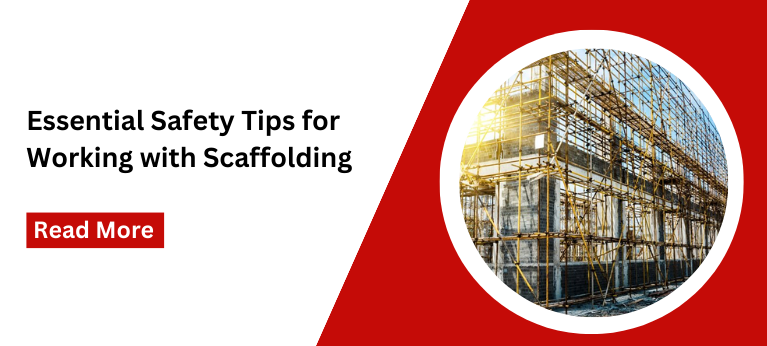Working with scaffolding is a fundamental aspect of many construction projects, providing workers with the necessary support and access to complete tasks at various heights. However, scaffolding can also present significant hazards if not used properly.
Ensuring safety while working with scaffolding is crucial to prevent accidents and injuries. Here are essential safety tips to follow when working with scaffolding.
1. Understanding Scaffolding Basics:
1.1 Types of Scaffolding
- Supported Scaffolding: The most common type, consisting of one or more platforms supported by rigid, load-bearing members such as poles, legs, frames, and outriggers.
- Suspended Scaffolding: Platforms suspended by ropes or other non-rigid, overhead support.
- Rolling Scaffolding: A type of supported scaffold set on wheels, allowing it to be easily moved.
1.2 Scaffolding Components
- Standards: Vertical tubes that transfer the entire weight of the structure to the ground.
- Ledgers: Horizontal tubes that connect the standards.
- Transoms: Horizontal cross-section load-bearing components that hold the boards in place.
- Couplers: Fittings that hold the scaffolding tubes together.
2. Proper Scaffolding Assembly and Dismantling:
2.1 Assembly Tips
- Qualified Personnel: Ensure that scaffolding is erected and dismantled by trained and experienced personnel.
- Manufacturer’s Instructions: Always follow the manufacturer’s guidelines for assembly and dismantling.
- Inspection: Inspect all components before use to ensure they are in good condition and free of damage.
2.2 Dismantling Tips
- Sequential Dismantling: Dismantle scaffolding in the reverse order of its assembly to ensure stability.
- Safety Gear: Use appropriate personal protective equipment (PPE) during dismantling.
- Area Clearance: Ensure the area below the scaffolding is clear of personnel and equipment to prevent injuries from falling objects.
3. Stability and Support:
3.1 Base Preparation
- Firm Foundation: Place scaffolding on a firm, level base to prevent sinking or tilting.
- Base Plates and Mud Sills: Use base plates and mud sills to distribute the scaffold load and prevent sinking.
3.2 Tying and Bracing
- Secure Ties: Tie the scaffolding to the structure at appropriate intervals to prevent tipping.
- Proper Bracing: Use diagonal braces to maintain the structure’s rigidity and stability.
4. Load Capacity and Weight Limits:
4.1 Understanding Load Limits
- Manufacturer Specifications: Adhere to the load capacity specified by the manufacturer.
- Worker and Material Weight: Consider the combined weight of workers, tools, and materials to avoid overloading.
4.2 Load Distribution
- Even Distribution: Distribute weight evenly across the platform to prevent tipping or collapsing.
- Avoid Concentrated Loads: Do not place heavy loads at one point on the platform.
5. Safe Work Practices:
5.1 Use of PPE
- Harnesses and Fall Protection: Use fall protection systems such as harnesses, especially when working at significant heights.
- Hard Hats and Safety Gear: Wear hard hats, non-slip footwear, and other appropriate safety gear.
5.2 Ladder Access
- Proper Access Points: Use ladders or stairways to access scaffolding platforms safely.
- Three Points of Contact: Maintain three points of contact (two hands and one foot, or two feet and one hand) while climbing.
5.3 Avoiding Hazards
- Weather Conditions: Do not work on scaffolding in extreme weather conditions such as high winds or lightning.
- Electrical Hazards: Keep scaffolding away from power lines and ensure no electrical hazards are present.
6. Regular Inspections and Maintenance:
6.1 Daily Inspections
- Pre-Work Check: Inspect scaffolding daily before use to identify any potential hazards or defects.
- Structural Integrity: Check for loose connections, damaged components, and proper bracing.
6.2 Maintenance
- Timely Repairs: Address any issues or damages immediately to maintain the integrity of the scaffolding.
- Component Replacement: Replace any worn-out or damaged components promptly.
7. Training and Education:
7.1 Worker Training
- Comprehensive Training Programs: Ensure all workers receive proper training on scaffolding safety, assembly, and use.
- Refresher Courses: Conduct regular refresher courses to keep workers updated on the latest safety practices and regulations.
7.2 Emergency Procedures
- Emergency Plans: Develop and communicate emergency procedures for scaffolding-related incidents.
- First Aid Training: Provide first aid training to workers to handle injuries promptly.
Conclusion:
Ensuring safety while working with scaffolding requires a comprehensive approach, encompassing proper assembly, stability, load management, safe work practices, regular inspections, and continuous training.
By following these essential safety tips, you can significantly reduce the risk of accidents and injuries, creating a safer working environment for everyone involved in the construction project. Remember, safety is a collective responsibility, and adhering to these guidelines can help achieve a successful and incident-free operation.



